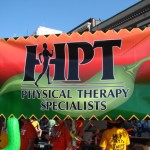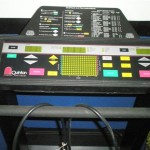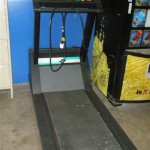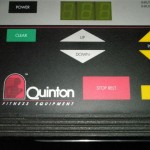HPT will be closed Monday, December 26th for Christmas and Monday, January 2nd for New Years Day. Make sure your appointsments for those weeks are scheduled on a Tuesday through Friday. If you have any questions, please contact our front desk at 304-525-4445.
Archive for Uncategorized
HPT Coat Drive
HPT will be having a coat drive Thursday, December 1st to Wednesday, December 21st. All coat donations will be taken to the Huntington City Mission on Thursday, December 22, 2010. There is a collection box in the HPT lobby to place your coats.
We are taking coats for children and adults, new and gentle used. Please make sure all coats are washed before bringing to the office.
If you have any questions, call 304-525-4445 and speak to Kevin Burton or Angie Slomke. The drop off address is 2240 5th Avenue.
A New Breed of Knee Injury in Young Athletes
Sometimes physicians will notice a medical trend well before science confirms its existence. That has been the case with injuries to the anterior cruciate ligament, the main ligament that stabilizes the knee joint, in young athletes. “Doctors who treat kids have all been saying over and over that the numbers of A.C.L. tears are going up dramatically,” says Dr. J. Todd Lawrence, an orthopedic surgeon and pediatric sports medicine specialist at the Children’s Hospital of Philadelphia. But surprisingly little firm data has confirmed that hunch.
So, for a study presented this month at the annual conference of the American Academy of Pediatrics in Boston, Dr. Lawrence and his colleagues parsed emergency room records of pre-adolescent youngsters treated at Children’s Hospital, looking for A.C.L. tears, as well as tears of the meniscus, the small pillows of cartilage that help to cushion the knee bones.
They also checked for fractures of the tibial spine, a fingerling spit of bone that extends from the tibia, or shinbone, to which the A.C.L. attaches. In prepubescent children whose skeletons are still growing, the slender tibial spine can be weaker than the tissues of the A.C.L. and break under the pressures of hard twisting or planting of the knee, even as the A.C.L. remains intact. “There was a time when the tibial spine fracture was the knee injury of childhood,” Dr. Lawrence says. “Twenty years ago, medical textbooks usually included a statement saying that kids did not tear their A.C.L., that they fractured the tibial spine instead.”
But when the researchers examined the pediatric hospital records, from 1999 through early this year, they found only 155 tibial spine fractures, while there were 914 confirmed A.C.L. tears and 996 meniscus tears. More important, while the incidence of tibial spine fractures increased at a rate of about 1 percent per year during that period, the incidence of A.C.L. tears increased by more than 11 percent per year. The difference almost certainly was not a result of better equipment leading to better diagnoses of A.C.L. tears, Dr. Lawrence says. “Even in 1999, M.R.I. technology was quite good,” so it was possible for physicians to differentiate between the injuries.
Which means that increasingly large numbers of young athletes, both boys and girls, are now suffering an injury to which doctors once thought they were almost immune.
Most of the A.C.L. tears that were treated at Children’s Hospital and picked up by this study, Dr. Lawrence points out, also involved a simultaneous meniscus tear, an indication of just how much wrenching and grinding the knee had undergone. Injury patterns have changed, he continues, because childhood sports have changed. “There’s a developmental soccer team here” in Philadelphia, he says, “for U-6 players,” meaning a competitive, select team for 4- and 5-year-olds. “When I heard that, I said, are you kidding me?”
The long-term effects of sports-related A.C.L. and meniscus tears in youngsters remain largely unknown, in part because such injuries were so rare decades ago. But there are indications that the consequences could be calamitous.
Recent studies of adult Swedish soccer players who tore an A.C.L. found that, within 12 to 14 years after the injury, 51 percent of the female players and 41 percent of the men had developed severe arthritis in the injured knee. The same time frame could have an injured 10-year-old dealing with a severely arthritic knee before he or she is 25. Meanwhile, many athletes who return to sports after an A.C.L. tear report that they don’t play as well, according to a new study of 500 Australian athletes, and a third of the athletes in that study did not return to any activity afterward.
“It’s definitely not a minor injury,” Dr. Lawrence says, “and it’s not something you want to see in a child.”
Whether anything can be done to lessen the toll on young knees, though, is uncertain, he and other researchers say. Knee injury prevention programs, including those that teach balance and proper landing techniques, have shown some utility in reducing the incidence of A.C.L. tears, especially in girls. But the programs are relatively new and have not been universally successful, in part, perhaps, because they can make some young athletes overly self-conscious, as an interesting review article published earlier this year suggests. In teaching children to think overtly about how to plant a leg or bend a knee while maintaining balance, some youngsters may become less fluid in their movement, more ungainly — and potentially ripe for injury, the review’s authors speculate.
A better solution would probably be to stop assuming that children can train like miniature Ronaldos or Kobe Bryants. “A lot of what we see in our injury data is almost certainly due to a statistical measure called exposure hours,” Dr. Lawrence says. “The more you do a risky activity at a high level, the more likely you are to get hurt.” His advice? “Encourage kids to play multiple sports and not to do any one sport year-round, and especially not when they’re 5 or 6, or even 9 or 10. They’re kids. Let them play and have fun, like kids.”
Shoulder pain causes can be prevented or minimized by: John Oxley, PT
Surprisingly, between 18 and 31 percent of the adult population experience shoulder pain during any 30-day period. There are many causes of shoulder pain including rotator cuff tendonitis or tears, adhesive capsulitis, shoulder instability and osteoarthritis. If we can identify risk factors for these conditions, we can prevent or at the very least minimize the problem.
Some lifestyle risk factors for shoulder pain and more specifically rotator cuff issues include obesity, tobacco use, and type 1 diabetes mellitus. These risk factors are believed to contribute to rotator cuff tears because of the restriction of blood flow related to nicotine and diabetes. The rotator cuff tendon suffers from limited blood flow anyway making it more susceptible than other tendons to chronic injury and tearing. Other risk factors that make people susceptible to shoulder injury include working with arms above shoulder level; hand-arm vibration; repetitive movements; pushing and pulling; and carrying loads supported by the shoulder.
A proactive approach to shoulder health includes brief daily stretching, posture improvement, intermittent rest breaks from overhead activity, and early identification of shoulder dysfunction. Early identification is extremely important because shoulder problems can get significantly worse if ignored and depending on the condition can be irreparable if unchecked. Conversely, acute shoulder pain responds well to intervention and early treatment can decrease productivity loss dramatically.
There are some seasonal activities on the horizon that are a common complaint and source of pain for my patient population: Raking leaves, shoveling snow, putting up Christmas decorations/lights, and weight training associated with early new years resolutions are just a few. You cannot avoid these activities, but you can be smart while undertaking these “must dos” by doing the following:
Take frequent rest breaks to change body position.
Don’t try to finish it all at once.
Use a ladder for reaching places overhead. Be careful when using a ladder, because the injuries associated with falling off a ladder can be far worse than a little shoulder pain.
Early treatment is important when it comes to treating shoulder problems efficiently and effectively. This is especially true when it comes to suspected rotator cuff tears because ignoring the problem can have catastrophic repercussions in some instances. Adhesive capsulitis is another condition that the research has recently supported treating early to prevent further freezing or loss of motion.
If you simply know that your shoulder hurts and don’t really know why then you should have a physician or physical therapist evaluate you. Possible treatments include steroid injections, surgery, oral medications or physical therapy to address your pain or limitations in function. In conclusion, be aware of shoulder position during seasonal or work activities, a healthy lifestyle can positively effect your joint health, and don’t wait to address your problem because the earlier it is addressed typically the more successful we are with treatment.
If you have any questions, email John at joxley@hptservices.com.
HPT Wins 3rd place at ChiliFest 2011
September 17, 2011 was a fun day for the HPT staff that worked the ChiliFest. This was our first year at the ChiliFest and we all had a blast spending time together and serving chili to the Tri-State. We won 3rd place in Best Booth and Showmanship and came in 7th place for People’s Choice. Thank you to everyone who visited our booth. Come back and visit our booth next year.
HPT Banner for ChiliFest
3rd Place Prize for Best Booth and Showmanship
HPT Crew at the ChiliFest
Chili Fest 2011
The 28th WV State Chili Championship is Saturday, September 17th on 3rd Avenue in Huntington. All proceeds go to the Ronald McDonald House Charities of the Tri-State. There will be judging of Red Chili, Chili Verde and Salsa. HPT will have a booth and dishing up some great tasting chili.
Mark your calendars to come to Huntington Chili Fest on Saturday, September 17th to support a great cause and taste chili, salsa and chili verde.
Treadmill For Sale
HPT has a Quinton treadmill for sale. The treadmill is in good condition and takes a 220 volt outlet. If you want to look at it, call 304-525-4445 to talk to Kevin.
Herald Dispatch article on Wellness
Some employers helping workers get fit
June 05, 2011 @ 12:00 AM
BETH HENDRICKS
The Herald-Dispatch
HUNTINGTON — In January, Huntington Physical Therapy and the HIT Center turned what they do for the outside world inside.
After years of caring for everyone else, owner and physical therapist Sally Oxley took a hard look at helping her employees take better care of themselves.
“I’d been reading about workplace wellness programs and decided we needed to have one because we are a health care facility and we need to practice good health habits,” she said. “We’re also self-insured so the added bonus is that we can save money, which means more money for our staff.”
A February 2008 study in the Journal of Occupational and Environmental Medicine showed that employers can save $1.65 in health care expenses for every dollar spent on a comprehensive employee wellness program. The federal government has even acknowledged the benefits of wellness programs, offering federal grant money to help small employers launch programs and allowing reductions on the cost of premiums to employees who participate, through the new health care reform bill, the Affordable Care Act.
Still, it is not always easy for employers to get involved in the health and well-being of their employees.
“By and large, employers aren’t in the business of the personal health of their employees,” said Dr. Brian Caveney from Duke University. “It’s one thing to buy a health plan. It’s another to change the daily personal habits of employees. It’s not as easily solved as smoking, because eating is something we all have to do every day.
“We have to empower each individual worker to know more about their situation with education and tools and resources to make better choices.”
Amy Hanshaw, executive director of the HIT Center, got to work on developing a program modeled after what the HIT Center already does in helping its clients eat healthier and exercising. That includes establishing initial testing, workout protocol, a point system and logs for tracking weight and exercise time.
According to the American Journal of Preventive Medicine, employers who invest in worksite health promotion programs see improved morale, reduced turnover, healthcare cost containment and/or reduction and reduced absenteeism.
Sharon Covert at the Wellness Council of West Virginia said setting up such a program often depends on the size of the company.
“Small companies might set up challenges with another company or use incentives in their office. This gets the competitive juices flowing. The largest companies can set up workplace gyms, so they’re at an advantage,” she said.
The key, Caveney said, is reaching the right group of employees.
“There will always be a small group who think an employer’s going too far. People who already have extremely healthy outlooks and lifestyles are the most likely to sign up. The key is designing a program that reaches the people right on the edge of making changes who need that extra little push,” he said.
Oxley said the staff at the HIT Center would be happy to work with employers looking to set up a wellness program, and additional free resources are available through the Wellness Council of West Virginia. The Centers for Disease Control and Prevention is another option, offering LEAN Works!, a free web-based program that provides tools for designing effective worksite obesity prevention and control programs.
The bottom line is the difference it makes to employees like the HIT Center’s Angie Slomke, who lost nearly 40 pounds and won her company’s three-month wellness initiative by being deemed the person who gained the “highest fitness level.”
“I knew I needed to have a healthier lifestyle and when they offered the program, it seemed like a great way to do it,” she said. “I had the support of the staff and I was happy with the way the program was set up. I wrote down everything I ate and worked out seven days a week.”
“Everyone considered this a lifestyle change, not a diet,” Oxley said. “We hope to have other employees join in and become healthier alongside us.”
HPT Welcomes Kelly Akers, DPT
HPT would like to welcome Kelly Akers, DPT to our staff. Kelly is a 2008 graduate from Marshall University with a degree in Chemistry and a 2011 graduate from The University of Dayton with a Doctor of Physical Therapy degree. Kelly enjoys the outdoors and spending time with her family and friends. Call 304-525-4445 to schedule an appointment to see Kelly Akers, DPT for your physical therapy needs.
HPT Wellness Program
HPT started a Wellness program January 3, 2011 under the direction of Amy Hanshaw, HIT Center director. We had 9 participants to complete the first three months with a total weight loss of 180 lbs. Everyone participating in the program performed a Bod Pod, fitness test (pre and post) and was weighed in weekly by the HIT Center staff.
Everyone in the program considers this a lifestyle change, not a diet. We all have learned what we can and can’t eat to still continue to lose weight and become healthier. Several of the participants have set higher goals and are continuing to loss weight to get to a much healthier state in their life. The Wellness program is continuing in hopes of having other employees join in on the “lifestyle change” and become healthier along with everyone else.







